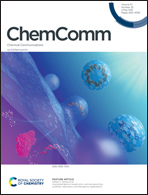Natural stereoisomeric flavonoids exhibit different disruptive effects and the mechanism of action on Aβ42 protofibril†
Abstract
Our simulations reveal that two enantiomeric catechins display a better disruptive effect on Aβ42 protofibril than their stereoisomer epicatechin. Unexpectedly, we find that catechins adopt both collapsed and extended states, while epicatechin populates only an extended state. Their different protofibril-disruptive effects are mostly attributed to the steric effect caused by the conformational differences.



 Please wait while we load your content...
Please wait while we load your content...